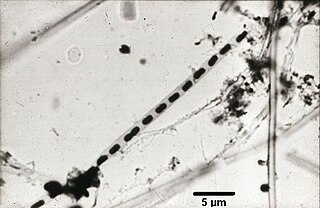
The Comamonadaceae are a family of the Betaproteobacteria. Like all Pseudomonadota, they are Gram-negative. They are aerobic and most of the species are motile via flagella. The cells are curved rod-shaped.
Zhihengliuella alba is a Gram-positive, non-motile, white-pigmented, short rod actinobacterium.
Dyadobacter alkalitolerans is a Gram-negative, aerobic, rod-shaped and non-motile bacterium from the genus of Dyadobacter which has been isolated from desert sand in Xinjiang in China.
Niastella is a bacterial genus from the family of Chitinophagaceae.
Niastella populi is a Gram-negative, strictly aerobic and non-motile bacterium from the genus of Niastella which has been isolated out of soli from a Populus euphratica forest in Xinjiang in China.
Pontibacter roseus is a Gram-negative bacterium from the genus Pontibacter which has been isolated from muddy water from a drainage system in Chandigarh in India.
Pontibacter xinjiangensis is a Gram-negative, rod-shaped and aerobic and non-motile bacterium from the genus Pontibacter which has been isolated from soil from Xinjiang in China.
Aeromicrobium flavum is a Gram-positive facultatively anaerobic and non-motile bacterium from the genus Aeromicrobium which has been isolated from air from the Wuhan University campus in China.
Haloechinothrix alba is a halophilic bacterium from the genus Haloechinothrix which has been isolated from soil from the Qijiaojing Lake in Xinjiang, China.
Prauserella marina is a bacterium from the genus Prauserella which has been isolated from ocean sediments from the South China Sea near China.
Pseudonocardia artemisiae is a bacterium from the genus of Pseudonocardia which has been isolated from the roots of the plant Artemisia annua in Yunnan in China.
Neptunomonas is an anaerobic and rod-shaped genus of bacteria from the family of Oceanospirillaceae.
Saccharopolyspora qijiaojingensis is a halophilic bacterium from the genus Saccharopolyspora which has been isolated from a salt lake in Xinjiang in China.
Thalassotalea is an aerobic and chemo-organo-heterotrophic genus of bacteria from the family Colwelliaceae which occur in the ocean and in sea ice.
Thalassotalea ganghwensis is a Gram-negative, aerobic and halophilic bacterium from the genus of Thalassotalea which has been isolated from tidal flat sediments in Korea.
Thalassotalea loyana is a bacterium from the genus of Thalassotalea. Thalassomonas loyana can cause white plague disease in the coral Favia favus.
Yimella is a genus of bacteria from the family Dermacoccaceae.
Barrientosiimonas is a genus of bacteria from the family Dermacoccaceae.
Sinomonas echigonensis is a bacterium from the genus Sinomonas.
Parasegetibacter luojiensis is a Gram-negative, strictly aerobic, non-spore-forming, heterotrophic and motile bacterium from the genus of Parasegetibacter which has been isolated from forest soil from the tree Populus euphratica from Xinjiang in China.
